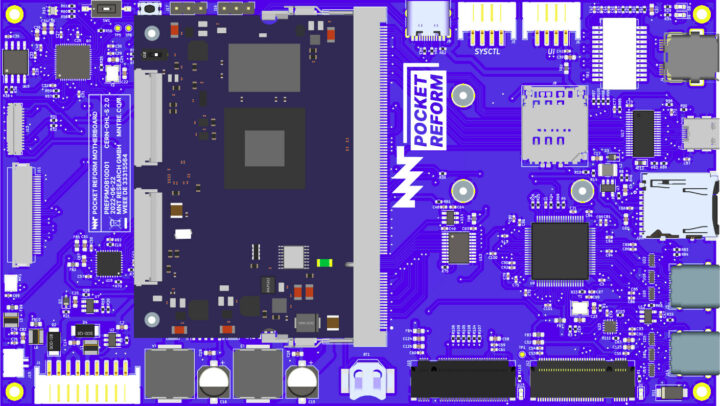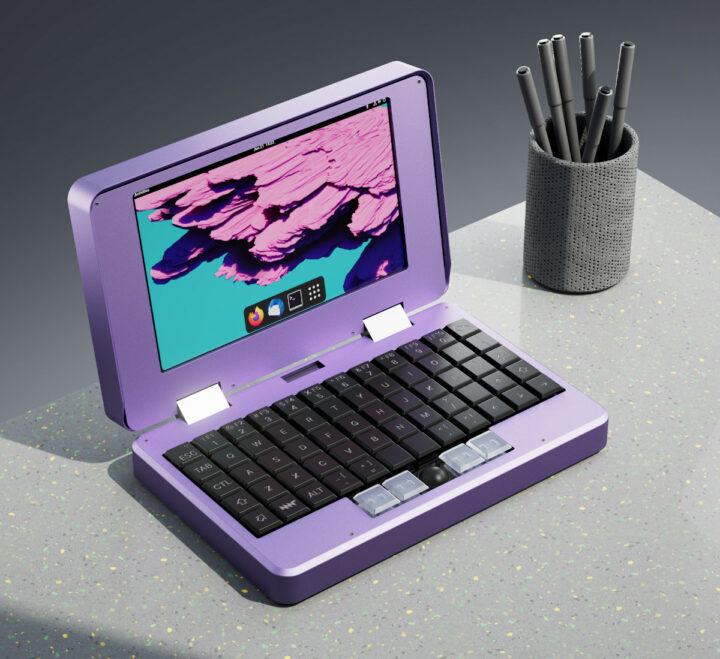MNT Pocket Reform is an open-source hardware mini laptop with a 7-inch Full HD display, an ortholinear mechanical keyboard, and trackball, that follows the path of its older and bigger sibling: the MNT Reform 2 laptop initially launched with an NXP i.MX 8M quad-core Arm Cortex-A53 module.
The new laptop will not only support a similar “NXP i.MX 8M Plus” module but also a range of other Arm modules namely an NXP Layerscape LS1028A module with up to 16GB RAM, the Raspberry Pi CM4 module via an adapter, Pine64 SOQuartz (RK3566, up to 8GB RAM), as well as based on AMD Xilinx Kintex-7 FPGA for industrial use.
MNT Pocket Reform specifications:
- Available system-on-modules
- Standard: NXP i.MX 8M Plus quad-core Arm Cortex-A53 @ 1.8GHz with 4 or 8 GB DDR4, Vivante GC7000UL GPU, 2.3 TOPS NPU
- NXP Layerscape LS1028A dual-core Arm Cortex-A72 with 8 or 16GB DDR4, Vivante GC7000UL GPU
- Raspberry Pi CM4 quad-core Cortex-A72 module with 8GB DDR4, VideoCore VI GPU (via adapter)
- Pine64 SOQuartz Rockchip RK3566 quad-core Cortex-A55 module with 8GB RAM, Mali-G52 GPU (via CM4 adapter)
- AMD/Xilinx Kintex-7 FGPA module (for industrial use, can run RISC-V softcore)
- Note: the modules are compatible with MNT Reform
- Storage
- Up to 128GB eMMC flash (depends on module selection above)
- NVMe SSD slot (up to 2TB)
- MicroSD card slot
- Full-disk encryption enabled by default
- Display – 7-inch display with 1920×1080 resolution, ~310 ppi
- Video Output – Micro HDMI up to 4K resolution
- Audio
- DAC with Mono Speaker
- MEMS Microphone (hardware switch)
- Headphones via USB-C audio adapter or Bluetooth
- Connectivity
- With NXP i.MX 8M Plus module: dual-band 802.11ac WiFi 5 and Bluetooth 5.0 module
- Optional industrial Ethernet port through RJ45 adapter cable
- Optional Mobile Internet with WWAN slot for 4G/5G/LTE modem and Micro SIM card slot (data or VoIP only, no calls/SMS)
- USB – 2x USB Type-C port, including one supporting USB PD
- User input
- Keyboard with ortholinear matrix, 60 keys
- Mechanical switches (Kailh Choc White)
- N-key rollover
- International layouts: US, UK, GER, FR, ES, DK, JP
- RGB backlight
- Optical 10mm trackball with 4 buttons
- Battery – 2x Li-Ion cells for 8,000 mAh in total
- Power Supply – USB PD port for charging
- Dimensions – 20 x 12.6 x 4.5 cm
- Weight – TBA
- Recyclable enclosures
- Variant A: Purple or Black anodized, bead-blasted Aluminum
- Variant B: Recycled PLA (biopolymer)
- Optional rubber bumper

MNT Research will also provide an eco-friendly sleeve to protect the Pocket Reform, and like the previous design from MNT, the mini laptop will be an open-source hardware design with full sources available, the ability to print your own parts, and the company also welcomes contribution and improvement of the device with mods from the community.
Debian GNU/Linux will be preinstalled, but other Linux distributions like Arch Arm, Ubuntu, and Void will also be supported, as well as Plan 9 (9front), Genode, and OpenBSD (in development). Desktops environments listed by the company include Sway windows manager & Wayland compositor, GNOME 4, and KDE Plasma.
MNT Research informed CNX Software that the beta program should open up in late July for “early adopters and adventurous hackers” in order to find bugs and issues, and help improve the finished product. You may find additional information in the announcement.

Jean-Luc started CNX Software in 2010 as a part-time endeavor, before quitting his job as a software engineering manager, and starting to write daily news, and reviews full time later in 2011.
Support CNX Software! Donate via cryptocurrencies, become a Patron on Patreon, or purchase goods on Amazon or Aliexpress






But how much?
On Aliexpress £230 will get you 7″ J3455 8GB or £266 gets 7″ J4125 8G ( don’t forget possible taxes ) who knows if customer support or Linux’s support.
New $98
Low-cost will not be the focus of the MNT Pocket Reform.
It will be cheaper than the MNT Reform 2, but quite more expensive than the cheap model mentioned in your comment. It’s not the same use case either.
So 4 different system-on-modules available, including the Raspberry Pi CM4. How do they achieve that? Does the mini-laptop have the connector interface the CM4 has got?
https://hackster.imgix.net/uploads/attachments/1356468/image_buPhJkVaPt.png
is there a benchmark available for
Unless you can name your use case benchmark numbers are useless. There’s CPU performance (with most use cases single-threaded performance being more important than multi-threaded), there’s GPU performance, there’s (often missing) VPU acceleration.
If it’s about CPU performance… RPi 4 is Cortex-A72, i.MX8 is A53 and RK3566 is A55. All with four cores at 1.8 GHz.
A55 is slightly faster than A53 especially with memory access. A72 is ~25%-30% faster than A55. With certain tasks / use cases the whole picture changes and an A55 might perform significantly faster than an A53 for example.
And all of this doesn’t matter much if you use this Reform thing for what it’s advertised.